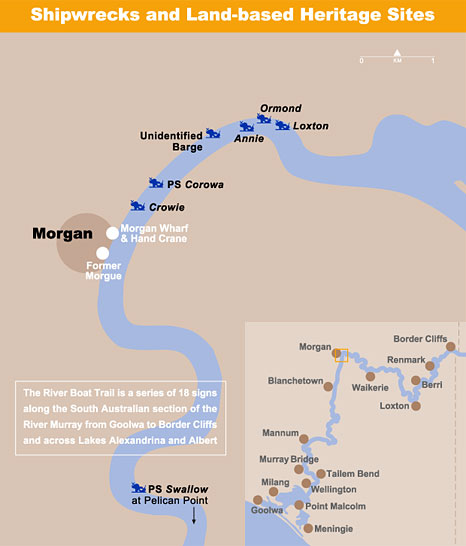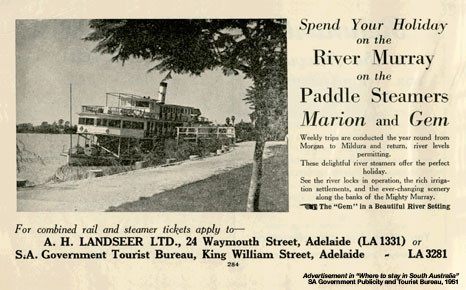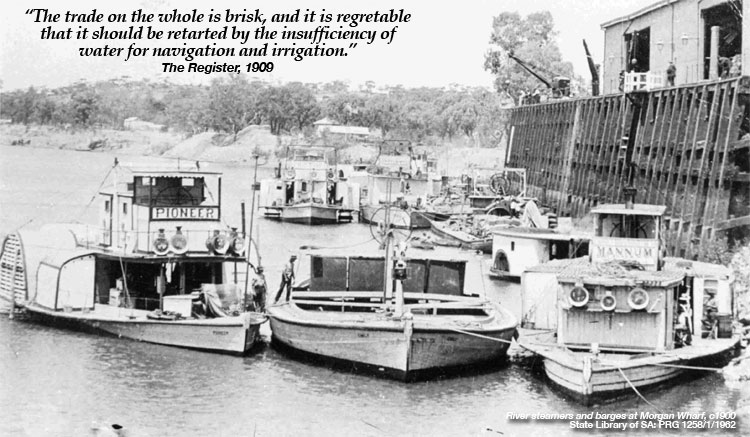
From 1880-1910 Morgan was the busiest inland port in Australia
 Port of Morgan
Port of Morgan
At the height of the river trade, from the 1880s to c1910, Morgan was the busiest inland port in Australia. Waiting steamers and barges often lined the river bank for half a kilometre.
Morgan was established in 1878 as the first railway terminus on the South Australian section of the Murray-Darling trade lost to the Victorian railway at Echuca.
The port became a significant trading hub in the colony, second only to Port Adelaide. The combined river and rail system was cheap, quick and reliable. During the high-water season, ganges of up to 40 men worked 24-hour rosters to handle the volume of goods crossing the Morgan wharf.
Up to six trains per day travelled to and from Adelaide; the wharf handled thousands of tons of cargo per annum, including much of the wool produce in inland Victoria and New South Wales; and passengers found that linking steamer and train trips was preferable to traveling by road.
By the end of the First World War the river trade had declined, although Morgan saw a brief resurgence when the irrigation towns were established upstream. The last paddle-wheelers to work out of Morgan, in the early 1950s, were the tourist vessels, PS Gem and PS Marion.
'Morgan...the river terminus of the Kapunda and North-West Bend Railway is an important Government township...A wharf nearly 400 feet in length with 4 steam cranes is provided for the shipment and discharge of goods to and from the interior. Morgan is the chief place for shipping goods an stores to stations on the river, and receiving their produce, particularly wool. During the season 1883-4 there were received 19,012 bales of wool and the exports during 1883 were valued at £238,453,
A goods and engine shed are here, a telegraph station, savings bank, and money-order office, an agency of the Bank of Adelaide, and a primitive Methodist chapel. Hotels; Terminus and Commercial. Steamers carrying mail and passengers leave weekly for Wentworth. Morgan is in daily communication with Adelaide by rail. Population 361."
The Australian Handbook of 1885
Tourist Boats
 Paddle steamers had always carried passengers as well as cargo, but by the 1890s a growing trend for 'a river cruise' saw a greater emphasis on passenger and tourism trade. This was reflected in the design and refurbishment of some vessels as well as improved catering and accommodation.
Paddle steamers had always carried passengers as well as cargo, but by the 1890s a growing trend for 'a river cruise' saw a greater emphasis on passenger and tourism trade. This was reflected in the design and refurbishment of some vessels as well as improved catering and accommodation.
The rail links at Morgan and Echuca offered exciting opportunities for travel between Adelaide and Melbourne of for tourists taking shorter excursions on the river.
As the cargo trade declined, the cruise and passenger focus became a new lease of life for many vessels. Both Victorian and South Australian tourism agencies promoted 'weekly circular trips.'
Passengers could plan their own itineraries, leaving the boats and making rail connections at a number of places along the river.
The two most popular vessels were the PS Gem and the PS Marion, both of which operated out of Morgan until the early 1960s.

River Wrecks
PS Corowa and Crowie Barge
A short distance upstream from the wharf are the remains of two vessels the epitomosed South Australia's riverboat era - the Corowa, a sternwheeler launched in Moama in 1868, and the Crowie barge, built at Goolwa in 1911. At 150 feet long and 30 feet wide, the Crowie was the largest barge built for the Murray River.
The Corowa and Corwie were abandoned in the mid-1940s and eventually sank. Both wrecks are usually exposed just a few metres from the shore.
A 'Plant'
The combination of steamer and barge was called a 'plant'. Barges increased the amount of cargo that could be carried, and were pushed, towed or lashed alongside the boat.
Loading a barge was an art - to avoid capsizing no cargo could be higher than two-thirds of the barge's width. Each barge had its own rudder and steering wheel that was raised as the barge was loaded.
A good barge master needed not only to keep the vessel from the bank and overhanging branches, but also to anticipate the skipper as the 'plant' rounded the sharp Murray bends.
Morgan Wharf
South Australia's largest river wharf
With an overall length of 168 metres, the Morgan Wharf was the largest landing stage on the South Australian stretch of the Murray River. It was built in three stages from 1877, but today only the later (1912) portion remains. The two earlier (southern) sections became unsafe and were demolished in 1994.
Building the wharf was an integral factor in the establishment of the Port of Morgan. The initial 61-metre structure redates the arrival of the railway in 1878. The length was doubled the following year, with an extension on the upstream side, and a further 46-metre addition was completed in 1912.
The wharf was constructed of redgum, with the landing stage eight metres above the average river level to allow for floods. In 1956 the flood level actually reached the same height as the wharf.
Platforms were built at different levels below the deck so that passengers and luggage could be loaded easily, but general cargo was handled by cranes on the wharf. Initially four steam-operatd cranes were used to unload the wool and whet into the large adjacent warehouses. They were later replaced by five hydraulic cranes.
The Morgan Wharf is a significant State Heritage Place reflecting the boom times of the river boat era and Morgan's dominance as Australia's busiest inland port. The structure is protected by the Heritage Places Act 1993.

| Cliff top GPS: Zone 54 E 0377511 N 6233129 Panel at the lookout and BBQ area opposite the Post Office |
Morgan Wharf GPS: Zone 54 E 0377558 N 6233108 Panel on the waterfront, between the old Railway Station (now museum) and the wharf |
Interpretive panels are located at:
River Boat Trail | Border Cliffs | Renmark | Berri | Loxton | Waikerie | Morgan | Blanchetown | Mannum
Murray Bridge | Tailem Bend | Wellington | Meningie | Point Malcolm | Milang | Goolwa
Please do not interfere in any way with ship-wrecks and land based heritage sites
Published with permission of Government of South Australia
Department for Environment and Heritage
Tell your friends you found this at murrayriver.com.au!
Copyright Discover Murray 2026. This site or any portion of this site must not be reproduced, duplicated, copied, sold, resold, or otherwise exploited for any commercial purpose that is not expressly permitted by DISCOVER MURRAY.






 Kevin Bloody Wilson Aussie Icon Tour with special guest Jenny Talia
Kevin Bloody Wilson Aussie Icon Tour with special guest Jenny Talia Lee Kernaghan Boys From The Bush The Concert
Lee Kernaghan Boys From The Bush The Concert The Australian Beach Boys Show
The Australian Beach Boys Show Amy Shark The Solo Acoustic "Songs & Stories" Tour
Amy Shark The Solo Acoustic "Songs & Stories" Tour Little By Little
Little By Little